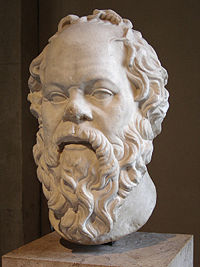



| Communities Resolving Our Problems: the basic idea | ||
| [SUP: Finding Problems] | [THINK: Shaping Problems] | [LEAP: Solving Problems] |
The Socratic Method is a chain of questions and summarizing ideas that seeks the truth of some topic, and in its purest form, this pattern includes only questions. The point of the questions is to use critical thinking skills to find false paths and dead ends in the reasoning process which leads to the correct decision or the right path to follow. That is, the questioning process can also be seen as a problem solving process, a topic more fully addressed in the Solving Problems section. The focus here is how to shape the process. How does one know how to shape the flow of questions to reach the goal or answer sought?
Perhaps most helpful to understanding is to see examples of the Socratic Method in action. One example is Garlikov's demonstration of Socratic questioning to teach the concept of binary numbers to third graders in some 30 minutes time by only asking questions. The more one knows about the topic, the easier it is for the questioner to play Socrates using logic and analysis to invent the right next question. However, there are many questions for which even the questioner will not have a target answer that they are seeking, other than the target of exploring the truth of idea or concept.
To help a discussion group develop such skills, playing the game of 20 questions can help to see the value of some underlying analytical strategy. For example, the first questions often ask whether the subject or topic could be living or not then if living, whether it is a plant or animal. The group needs to work on identifying logical strategies.
There is no simple recipe to follow in generating the chain of questions. To engage others it is helpful that the topic is relevant or of some interest to those in the discussion. The lead questioner is engaged in analysis, in breaking things down into logical parts. The first questions must get at what the group knows which provides a starting place. Sometimes it is useful to pause to summarize the conclusions that have been reached after a period of time or a certain level of complexity has been built up. Skills with analysis will lead to the questioner to the next question that leads to the next thing the group needs to know. Some of analysis can be done before a discussion, but analysis will continue as it is impossible to predict all the paths the question process might follow. Further, once the group becomes more familiar with the method, there is no reason that any member of the group cannot offer a question to keep the thread or chain going when the lead questioner cannot find an appropriate next question.
Law schools (e.g., University of Chicago's Law School) often use this method of asking a stream of questions about an initial point of view or idea seeking to reveal a contradiction, which if found then invalidates the initial assumption, a handy skill in considering legal questions. Thinkers caught in their own illogical concepts however can be irritated or even angered by such an approach. It was the citizens of Athens that became so angered by Socrates that they tried him for corrupting their youth and ordered his death. It is important to develop a non-authoritarian attitude among all members of the group or team that helps everyone feel comfortable with this discovery process, not making it a development which intimidates a participant.
The Socratic Method and the Scientific Method share many similarities (Dye, 1996, 2007), notably that they both begin with wondering. They differ with science's focus on only those phenomena which can be reliably and repeatedly observed. In contrast, the Socratic Method is used to address any topic to which logic can be applied. That is, though the method can be used to teach basic facts through discovery and construction, it is available to address questions of character development, of best choices and what is right and wrong, the basic questions of philosophy and religion.
 On a historical note, most of what we know about Socrates (picture on left from Wikipedia) comes from the writings of Plato, a pupil or student of Socrates. Socrates, who lived from 469 –399 BC in Greece, was illiterate, as was common over 2,000 years ago. Plato (around 428 – 348 BC) wrote in a style of literature common at the time, called Socratic dialogue. The set most commonly agreed upon by scholars as Plato's writings include: Parmenides, Phaedrus, Republic, and Theaetetus and his later works, Critias, Timaeus, Laws, Philebus, Sophist, and Statesman. The translated versions of these works with commentary can be found by seaching for Plato or title at at www.gutenberg.org.
On a historical note, most of what we know about Socrates (picture on left from Wikipedia) comes from the writings of Plato, a pupil or student of Socrates. Socrates, who lived from 469 –399 BC in Greece, was illiterate, as was common over 2,000 years ago. Plato (around 428 – 348 BC) wrote in a style of literature common at the time, called Socratic dialogue. The set most commonly agreed upon by scholars as Plato's writings include: Parmenides, Phaedrus, Republic, and Theaetetus and his later works, Critias, Timaeus, Laws, Philebus, Sophist, and Statesman. The translated versions of these works with commentary can be found by seaching for Plato or title at at www.gutenberg.org.
THINK: Shaping Problems | Initial publication 10/9/2008 | Page author: Houghton